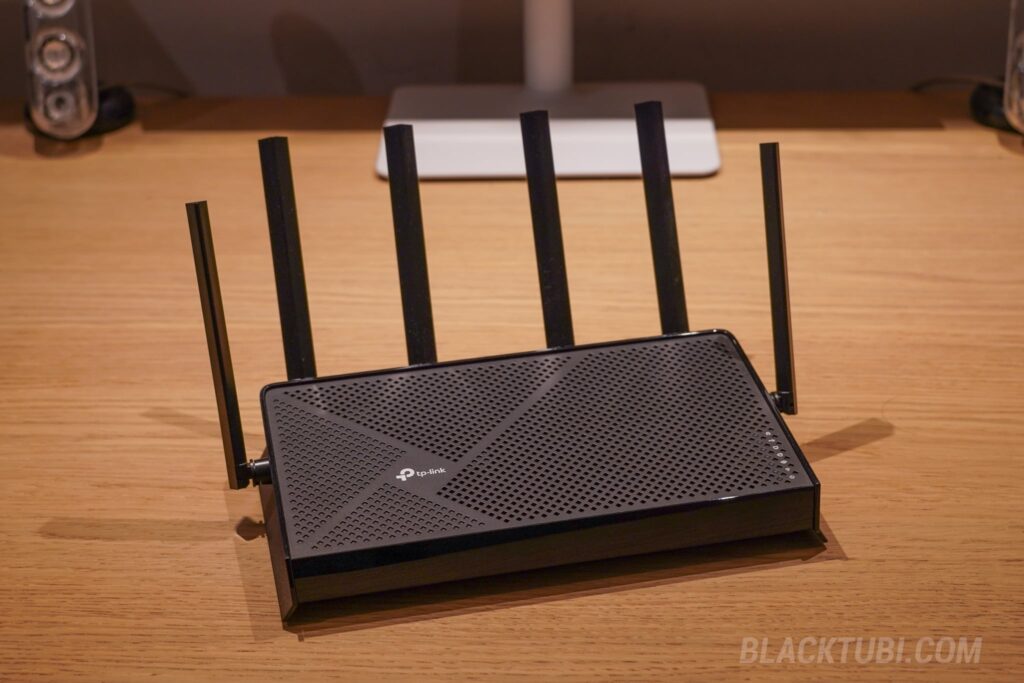
The TP-Link Archer BE400 is a mid-range WiFi 7 wireless router. It’s a significant improvement over its predecessor, the Archer AX73, which only supports WiFi 6 AX5400. The Archer BE400 supports WiFi 7 up to BE6500 with a dual-band 2.4GHz and 5GHz configuration. It also comes with a faster Quad-Core 2.0GHz CPU with 1GB DDR4 RAM to support more connected devices.
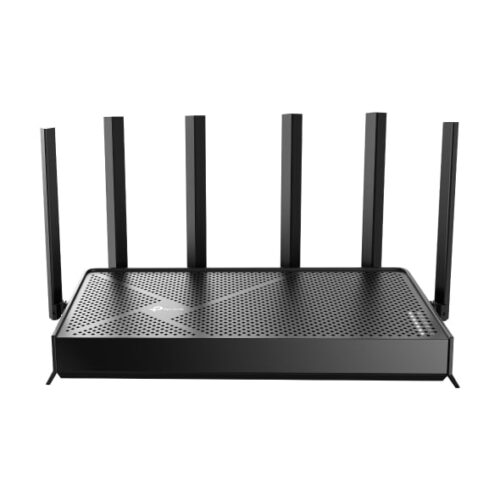
TP-Link Archer BE400
9.0
Tubi Rating
pros
- Excellent 5GHz WiFi Performance for WiFi 7 and WiFi 6 devices
- Comprehensive HomeShield parental control features
- Supports Wireguard VPN server and device selection for VPN access
cons
- HomeShield Pro Security and Parental Control requires monthly subscription
- Slow WiFi speed when MLO mode is enabled
Archer BE400 Hardware and Specs
| WiFi 2.4Ghz | Wi-Fi 7 up to 688Mbps (40Mhz 2×2) |
| WiFi 5Ghz | Wi-Fi 7 up to 5764Mbps (160Mhz 4×4) |
| CPU | Broadcom BCM6765 2.0Ghz Quad-Core |
| RAM | 1GB DDR4 |
| Ethernet Ports | 1x 2.5G WAN + 1x 2.5G LAN + 3x Gigabit LAN |
| USB | 1x USB 3.0 port |
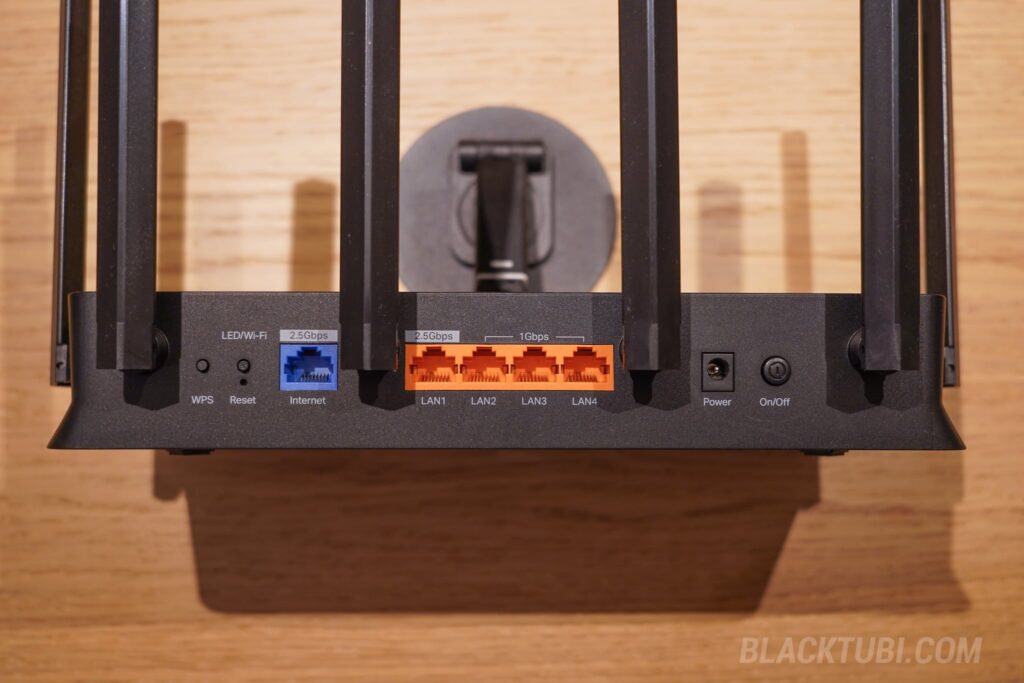
The Archer BE400 includes just a single 2.5G WAN and a single 2.5G LAN port. The remaining 3 LAN ports can only support Gigabit speed. That’s unfortunate as many WiFi 7 routers are already offering fully 2.5G LAN ports. There’s a single USB 3.0 port on the side of the router which can be used to connect a USB hard drive for file sharing on the network.
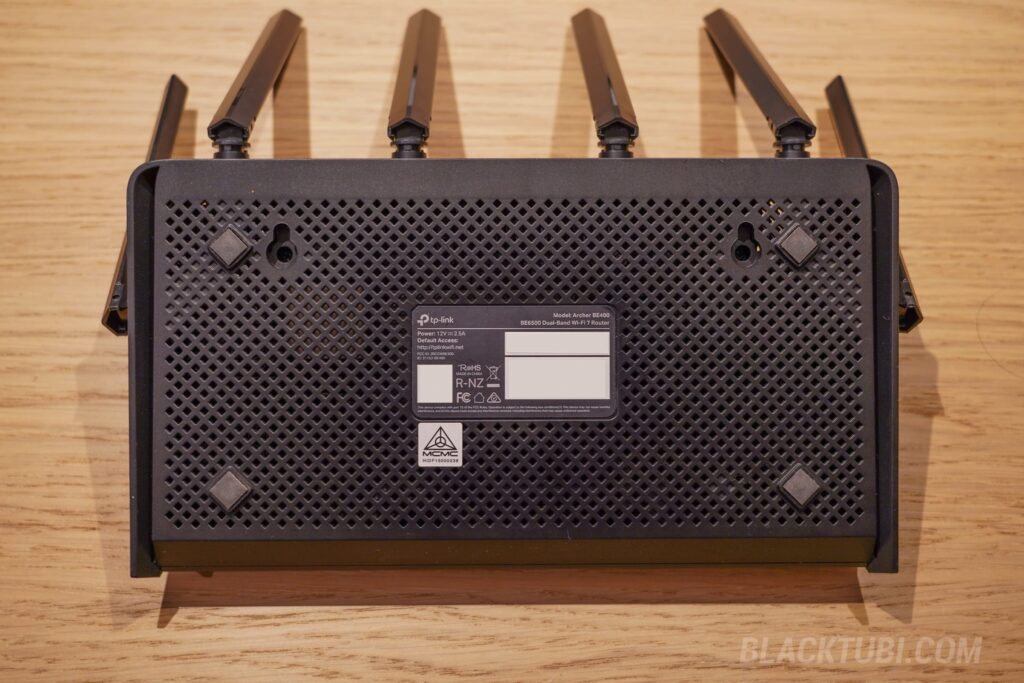
I particularly like the mesh design which offers plenty of ventilation for the router. The surface of the router is lukewarm even with consistent heavy stress tests. The Archer BE400 features excellent build quality with high-quality matte plastic. It also includes two mounting holes on the back, allowing for wall installation, something not possible on other TP-Link models like the Archer BE550 or Archer GE550.
Archer BE400 Teardown
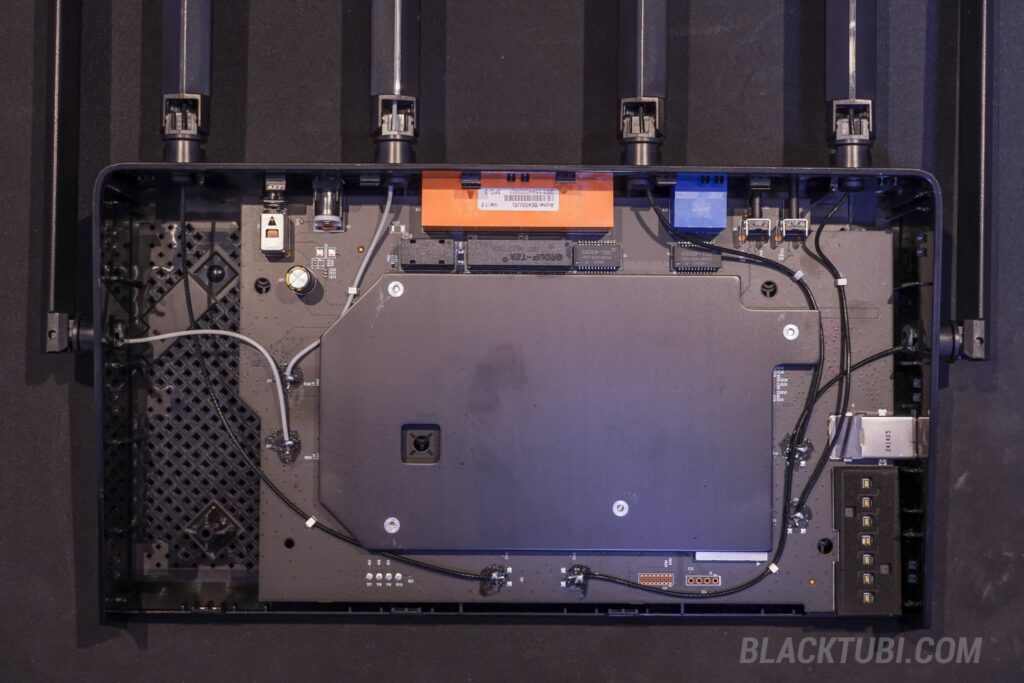
During our teardown of the Archer BE400, we found that TP-Link included a single heat spreader on the upper side of the PCB. We also found that the router is able to sustain heavy load despite not having a proper heatsink with fins. All the antennas are soldered directly to the PCB without connectors.
Archer BE400 WiFi Performance Test
Short Distance 5GHz WiFi 7
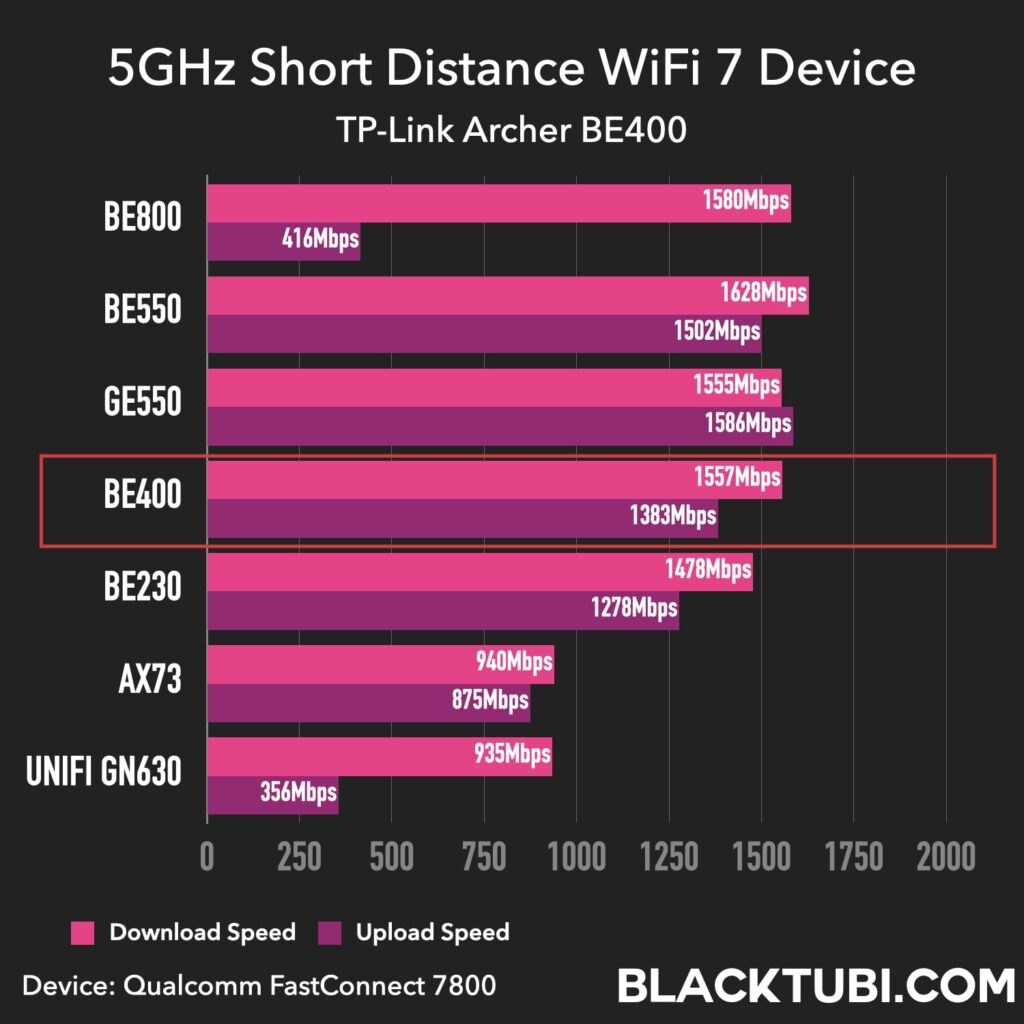
TP-Link’s recent WiFi 7 routers, including the Archer BE400, perform exceptionally well at short range. In our testing, the BE400 delivered fast and stable 5GHz speeds, comparable to more expensive models like the Archer BE800.
Short Distance WiFi MLO 7
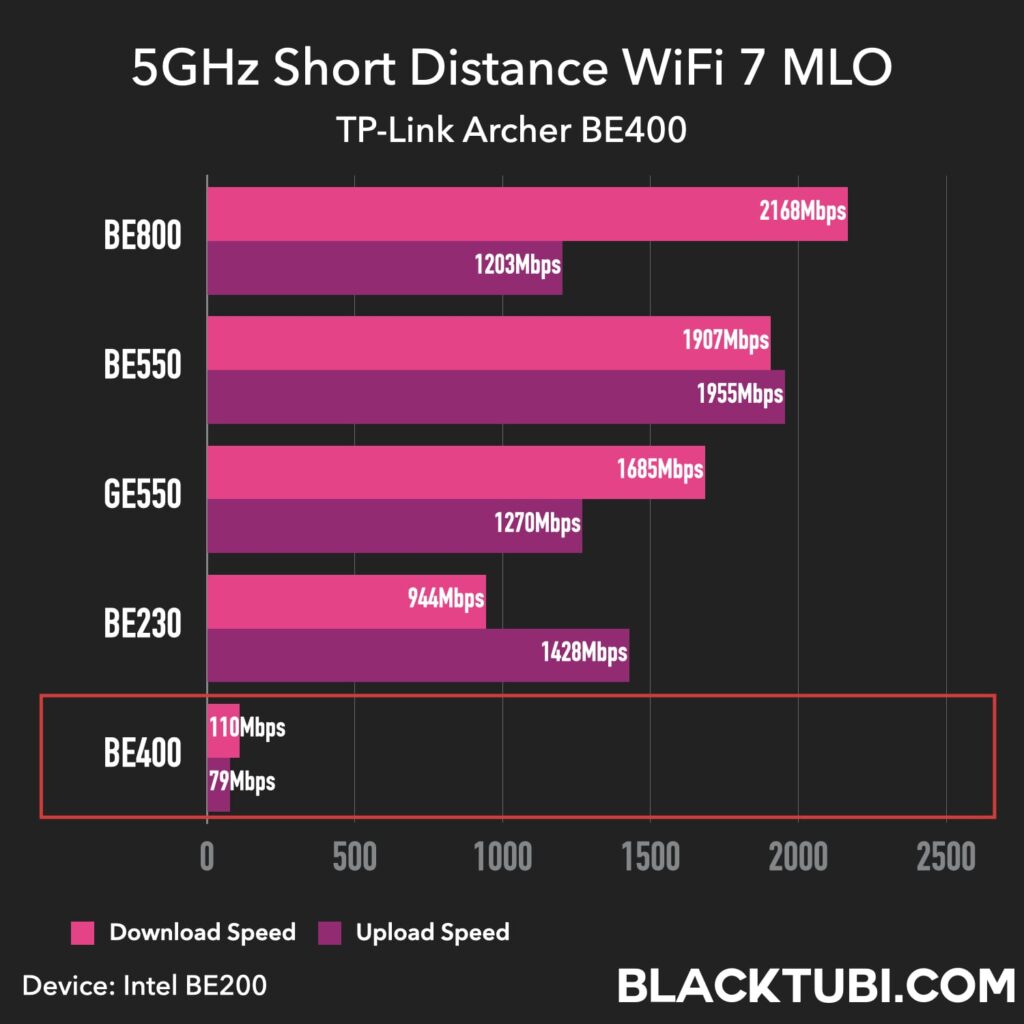
By default, TP-Link disables the MLO feature on all their WiFi 7 routers. Unfortunately, enabling the MLO network on the Archer BE400 results in poor WiFi performance on our test device equipped with the Intel BE200 wireless adapter. This issue is unexpected, as other TP-Link WiFi 7 routers did not exhibit the same problem. Until TP-Link provides a fix, we recommend keeping MLO disabled on the BE400.
Short Distance 5GHz WiFi 6
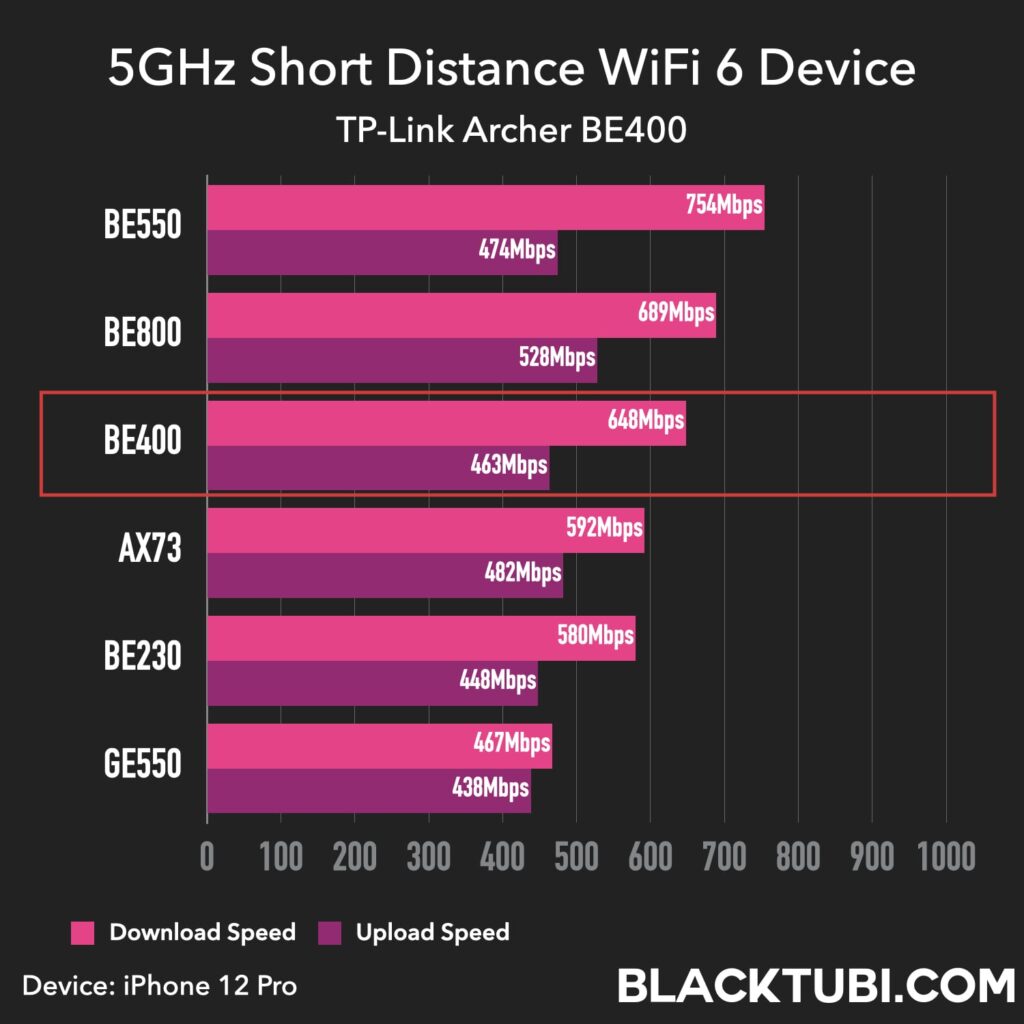
The Archer BE400 delivers excellent 5GHz WiFi performance, even on older devices like my iPhone 12 Pro, which only supports WiFi 6. In fact, it outperforms the Archer AX73 despite the test device not supporting WiFi 7, suggesting that TP-Link has implemented optimizations for legacy WiFi clients as well.
Long Distance 5GHz WiFi 7
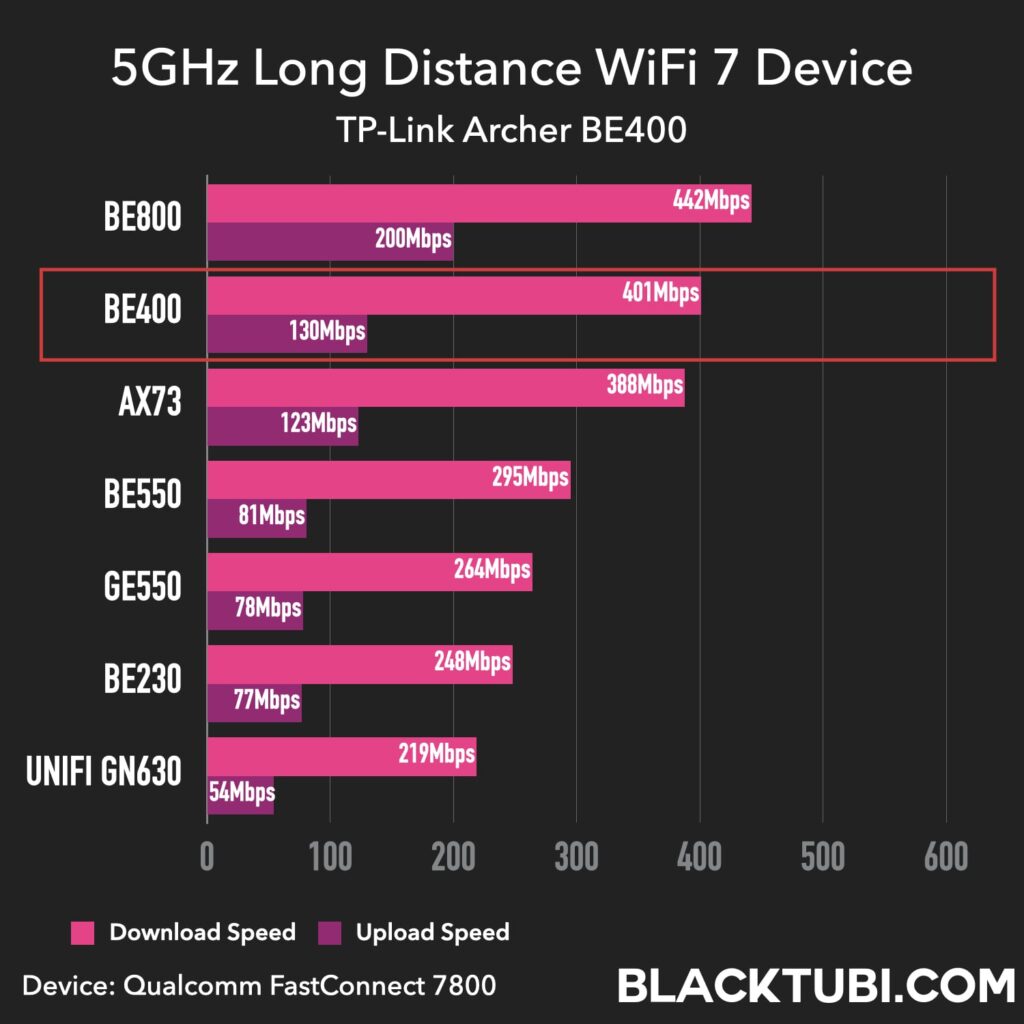
Long Distance 5GHz WiFi 6
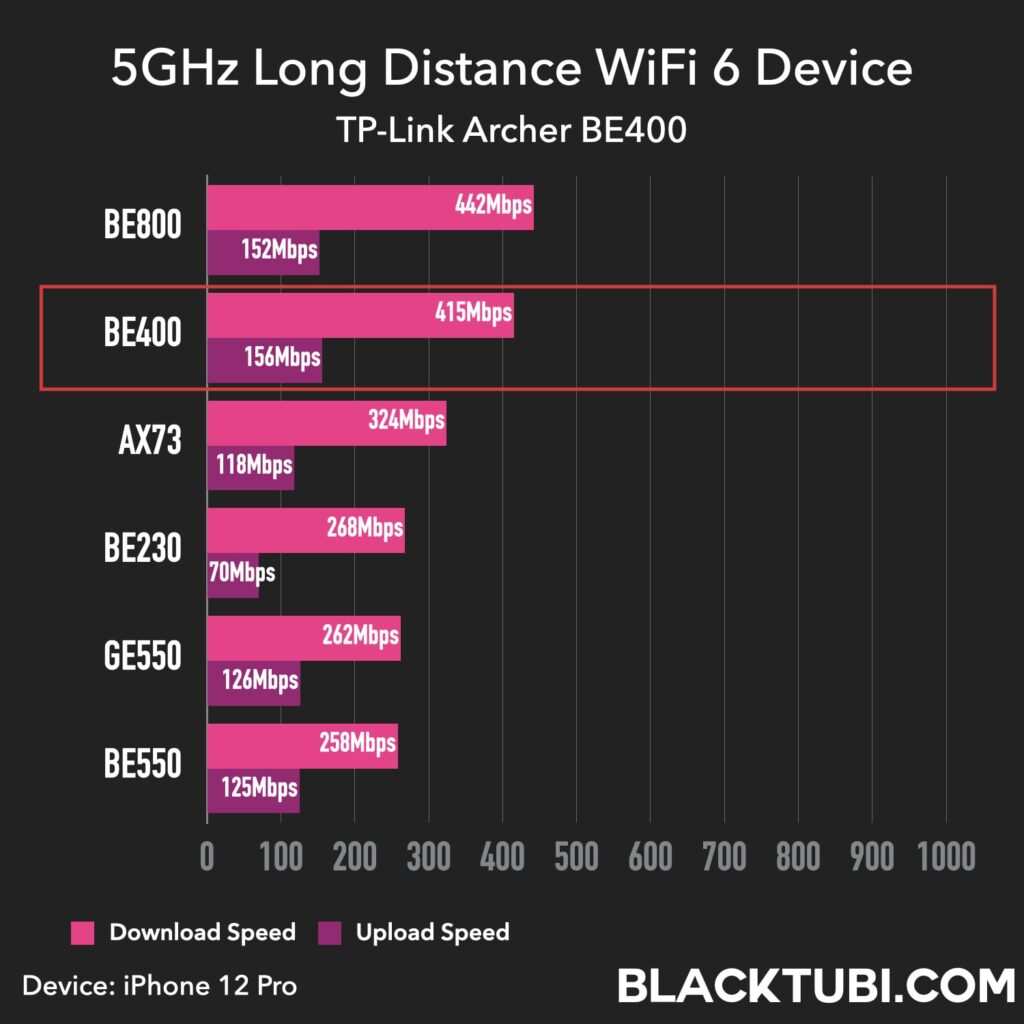
A similar trend was observed in the long-distance 5GHz test with a WiFi 6 device. The Archer BE400 outperformed both the Archer BE550 and Archer GE550, and even surpassed the AX73. This suggests that WiFi 7 routers like the BE400 can still bring performance benefits to older WiFi 6 devices like the iPhone 12 Pro used in this test.
Long Distance 2.4GHz WiFi 6
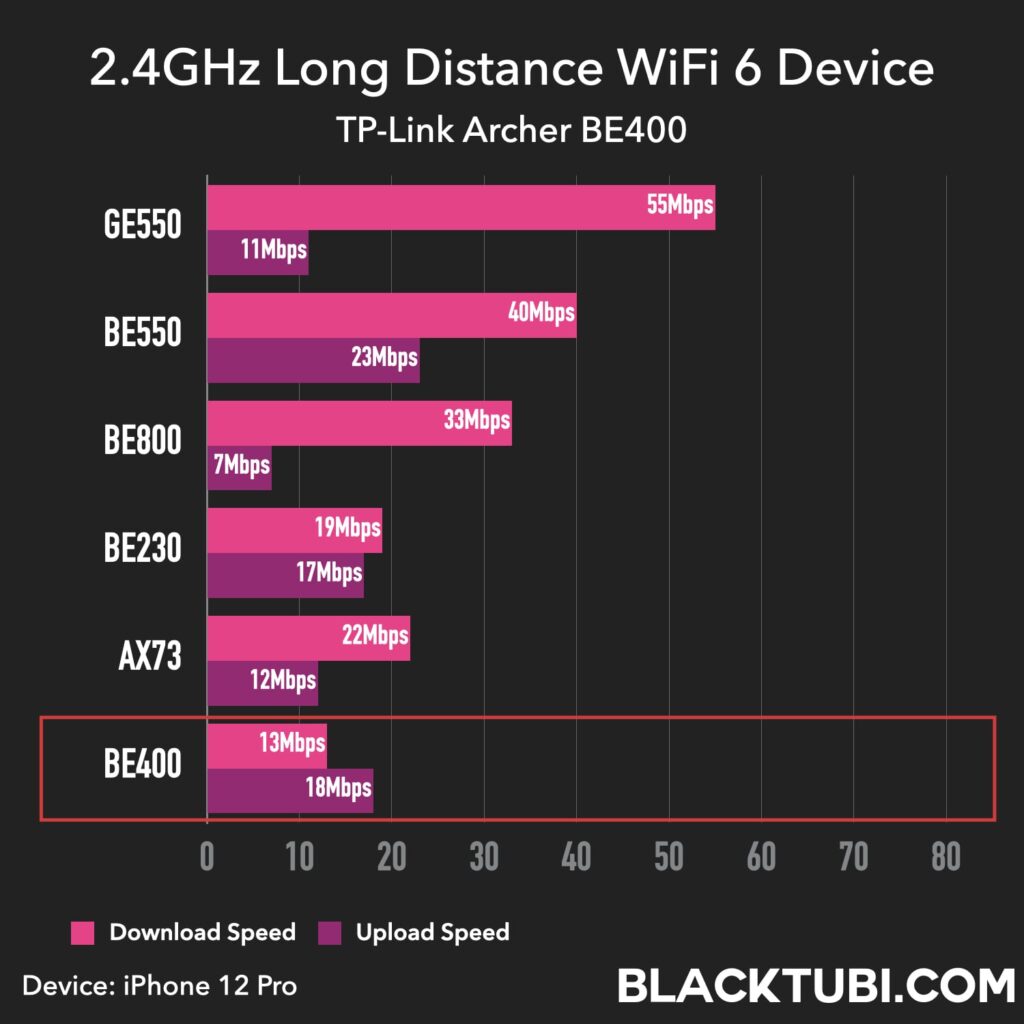
The 2.4GHz network on the Archer BE400 was noticeably slow in our long-distance test, likely due to high interference in our test environment. It was the slowest among all TP-Link routers we’ve tested so far, which could be a concern if you rely heavily on 2.4GHz IoT devices like smart cameras.
EasyMesh Feature Supported
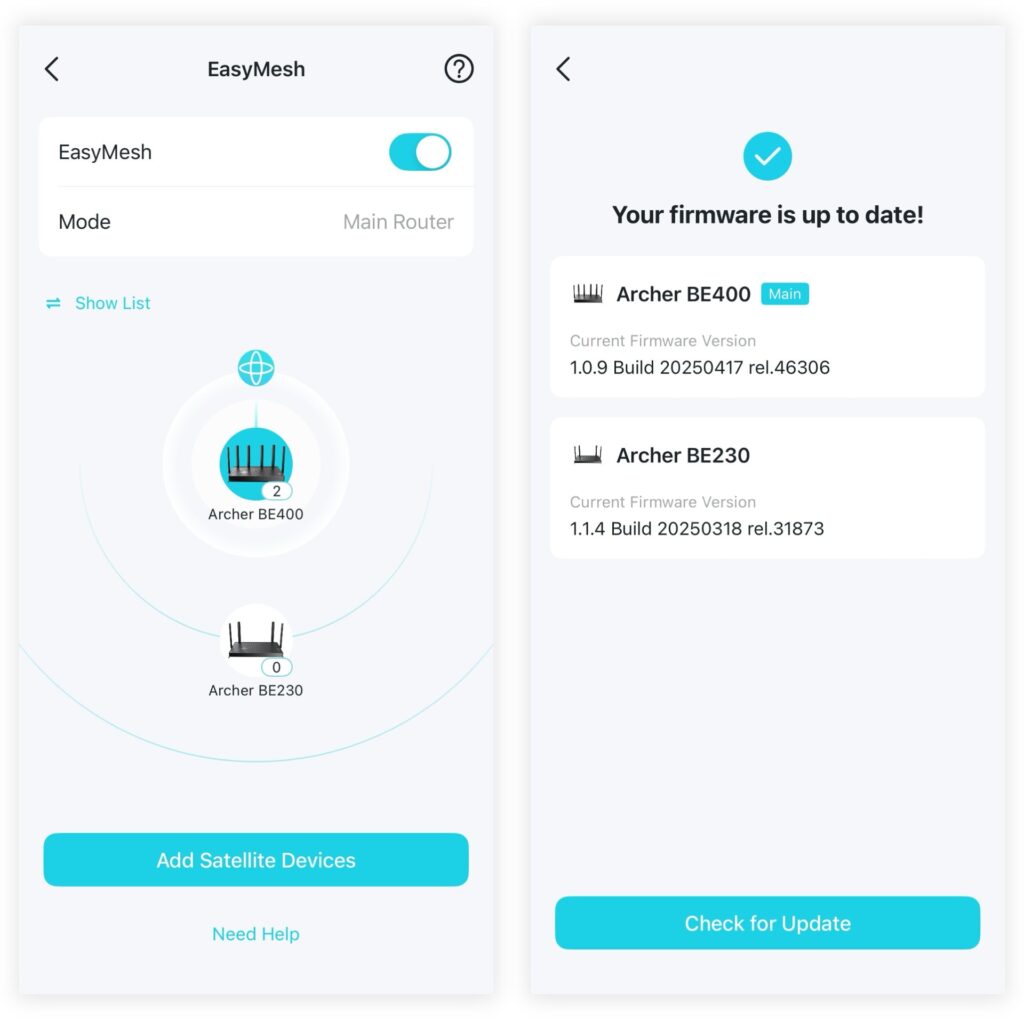
The Archer BE400 supports EasyMesh, allowing you to combine multiple EasyMesh-compatible routers into a single unified network. This creates a seamless mesh WiFi system that extends coverage and improves signal strength throughout your entire home. The mesh node will automatically use all available wireless band for the backhaul connection.
Setting up EasyMesh on the Archer BE400 is simple and seamless either through the web interface or the TP-Link Tether app. Adding nodes takes just a few minutes, and once connected, all configurations will be centralized on the master unit including network configuration and firmware updates.
Archer BE400 Mesh Features
Wired Backhaul: Yes ✅
AP Mode Mesh: No ❌
802.11r Fast Roaming: No ❌
802.11k/v Roaming: Yes ✅
Client Binding: No ❌
Signal Source Selection: No ❌
Guest WiFi on Node: No ❌
App Management: Yes ✅
USB Performance Test
Samba File Sharing
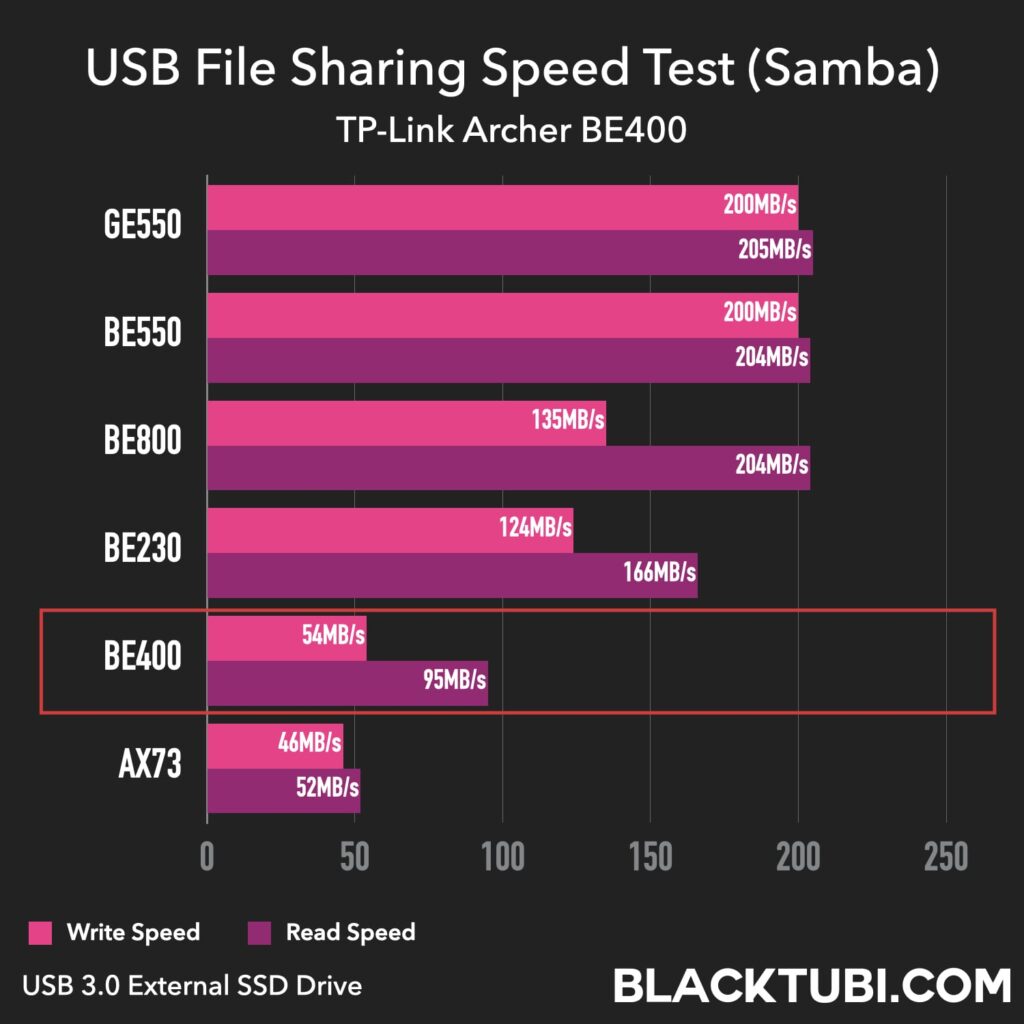
The USB file transfer speed on the Archer BE400 is slightly faster than the older Archer AX73 when I test it with a NTFS-formatted external USB SSD drive. However, it’s much slower when compared to other TP-Link products like the Archer BE550 or Archer BE230.
Archer BE400 USB Features
Samba Server: Yes ✅
FTP Server: Yes ✅
DLNA Server: Yes ✅
Time Machine: Yes ✅
Firmware and Features
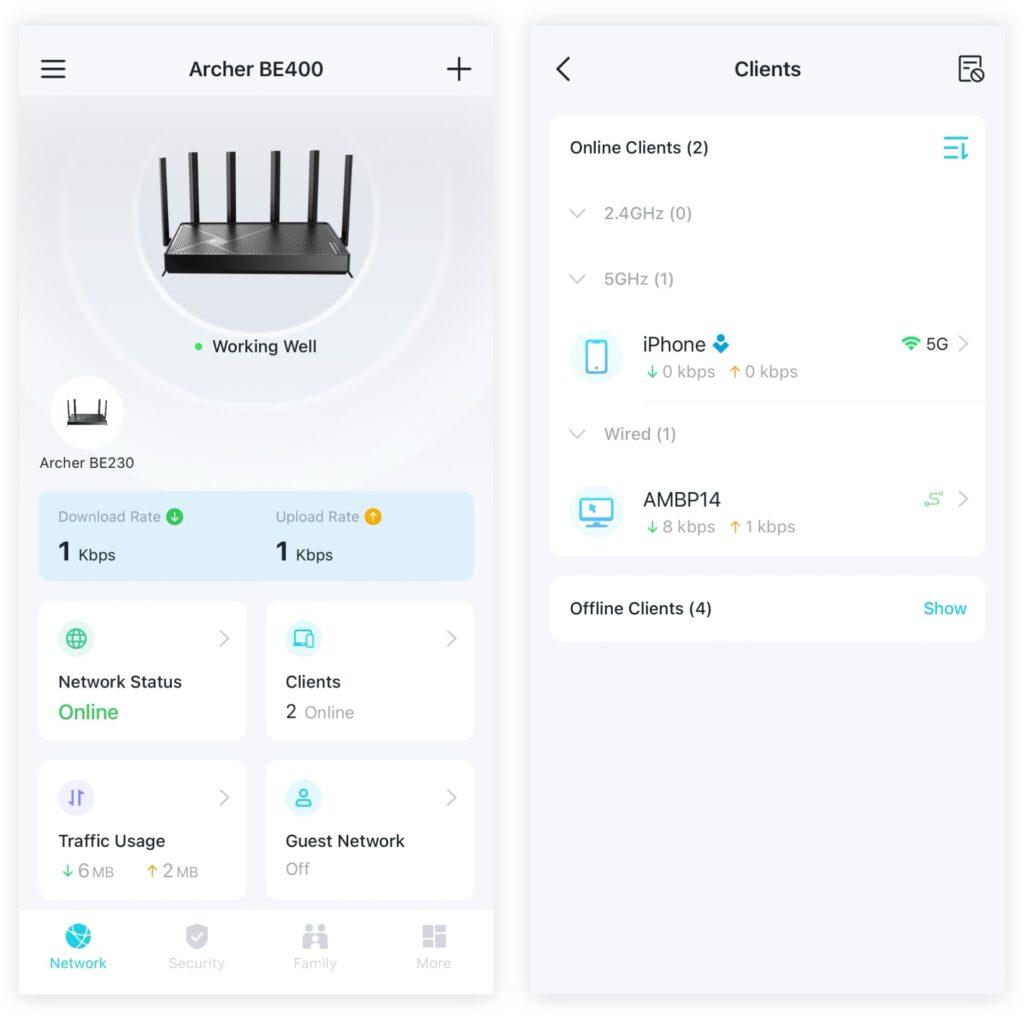
The Tether app offers an excellent user experience with a clean and responsive interface. It displays connected devices and lets you configure parental controls or speed limits for each device. I appreciate the detailed traffic usage tracking, which provides daily and weekly analysis per device. The speed limit feature is also handy for managing bandwidth usage on specific devices.

One of the standout features of the Archer BE400 is its enhanced VPN capabilities. It now includes native support for NordVPN and Surfshark, along with the faster WireGuard protocol. TP-Link has also added the option to apply VPN connections to specific devices, instead of the entire network.
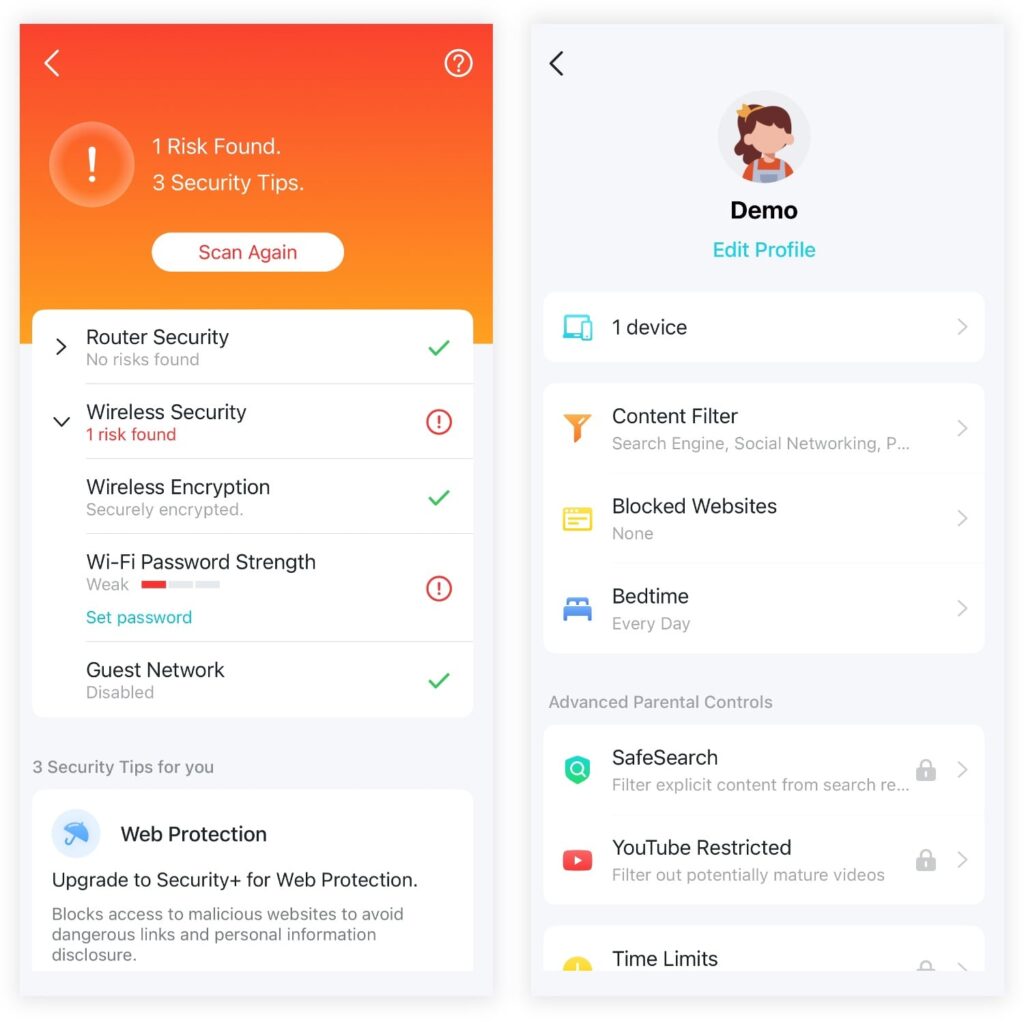
Unfortunately, the excellent HomeShield suite which offers advanced parental control and security features will require a monthly subscription and they are not included with the router. The basic parental control only offers page blocking and bed time limit. Advanced parental control features like Internet usage analysis, granular usage time scheduling will require the Pro subscription.
As for security, the Archer BE400 comes with a basic firewall and security scanner, common on most routers in the market. The advanced security features such as web content protection, intrusion prevention and, IoT Protection will require the HomeShield Security+ subscription service.
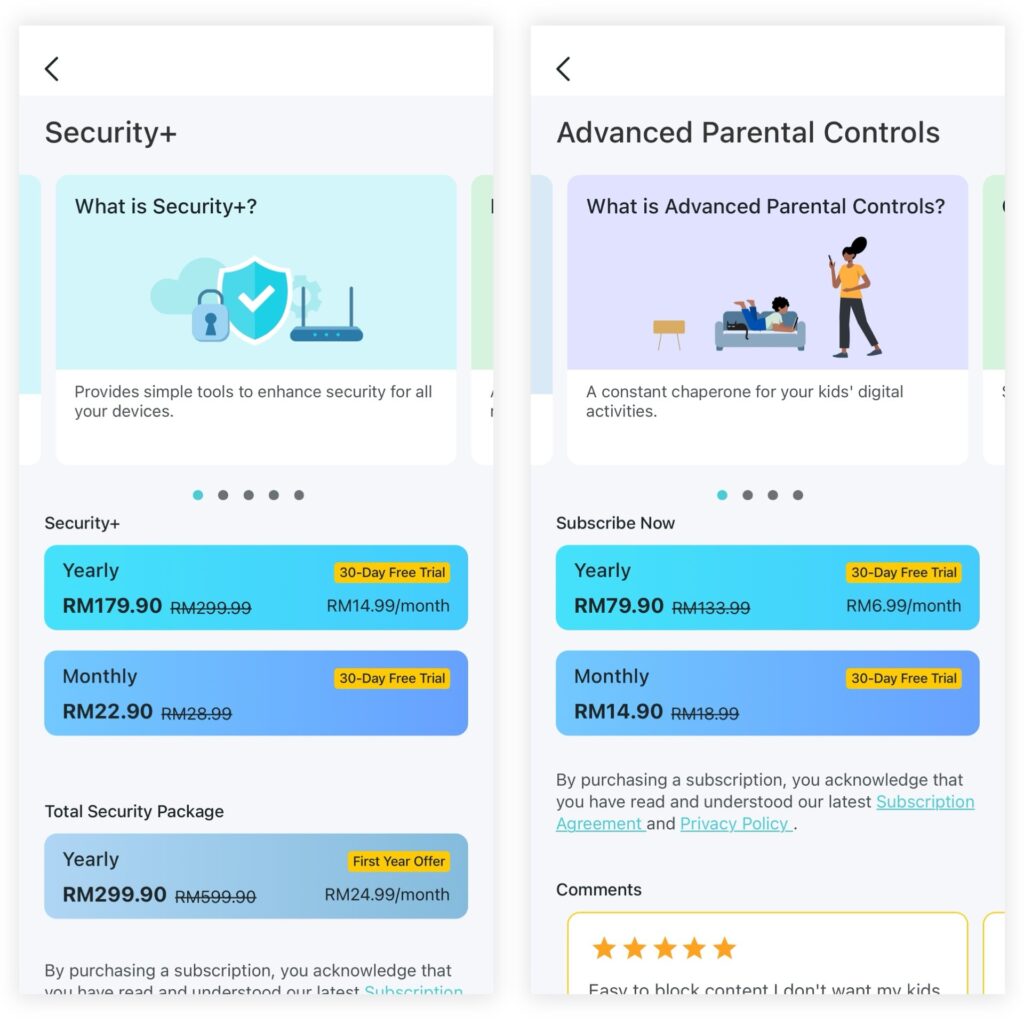
As of June 2025, TP-Link is offering a 30 days free trial for both the Security+ and Advanced Parental Control subscription. The monthly subscription will depends on the region but it is RM22.90 per month for Security+ and RM14.90 per month of the Advanced Parental Control service in Malaysia.
Additional Features
WireGuard VPN: Yes ✅
VPN Device Selection: Yes ✅
DNS over TLS (DoT): Yes ✅
DNS over HTTPS (DoH): Yes ✅
Printer Sharing: No ❌
EasyMesh: Yes ✅
Dual WAN: No ❌
VLAN Guest WiFi: No ❌
Repeater Mode: No ❌
Access Point Mode: Yes ✅
Closing Thoughts
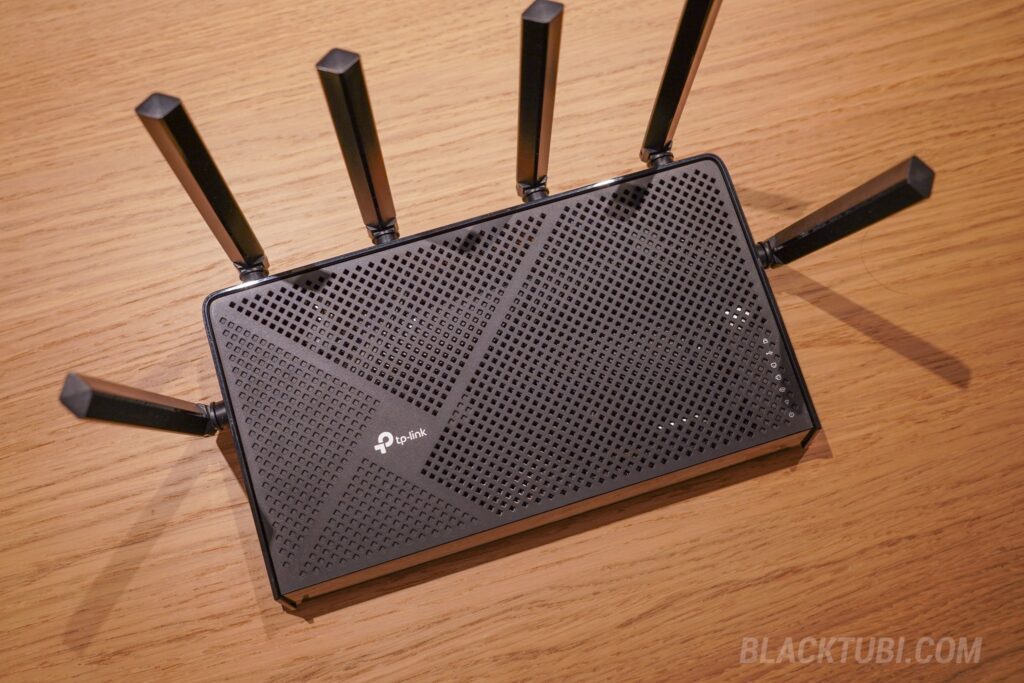
The Archer BE400 is an incremental upgrade over the popular Archer AX73, retaining a familiar design while offering enhanced performance and features. While WiFi 7 mainly benefits newer devices with WiFi 7 support, we also observed faster speeds on older WiFi 6 devices. That’s likely due to improved interference handling and overall radio optimization.
The Archer BE400 delivers excellent 5GHz performance, even surpassing some of TP-Link’s higher-end models. It’s a great option for users looking to upgrade their 5GHz WiFi network, even for older non-WiFi 7 devices. However, if you’re looking to take advantage of the 6GHz band, you’ll need to consider other models like the Archer BE550.

Hi Blacktubi,
Do you have a guide to setup Unifi on this router? Is your TP-Link router unifi setup guide still applicable? Thanks
It is still applicable.
Hey, what is the methodology used for long distance testing? e.g.: What is the distance, are there obstacles such as furniture, walls, windows, etc. ?
Roughly 6 meter distance in a high rise condominium with 2 steel reinforced concrete wall between the router to the client.
Yo Blacktubi.
Between BE400 and AX72/73, which one is better value if the household have a mix of wifi 5,6, and 7 devices?
I would buy the Archer BE400, it’s newer which means it will receive more firmware and security update. TP-Link usually don’t provide updates for their older router once they stop selling it so I recommend buying latest model whenever possible.
Hi Blacktubi,
Could you provide more details about the subscription price for the Advance Parental Control? My current Deco M5 router includes HomeCare, which has built-in parental control and antivirus features. I’m currently using 500 Mbps and plan to purchase a new router and an extender.
TP-Link doesn’t advertise the price elsewhere, and even the Shopee authorized seller didn’t provide any helpful feedback.
Hi Izwan, unfortunately, TP-Link no longer offers free advanced security and parental control feature. It is RM22.90 per month for Security+ and RM14.90 per month of the Advanced Parental Control service over here in Malaysia as at June 2025. There’s a yearly option with some discount, you may refer to my updated article with the pricing included.